

Tommy's towing toys
So, last week I mentioned that Tommy Ivo was putting together a little something for your reading enjoyment about his glass-sided haulers. I had dropped him a line to ask where he had gotten the idea, how they came to be, etc., and, as always, "your hero and mine" said that he would be happy to share his memories, even though he was knee-deep in a project of his own, an Ivo-riffic recap of his life and times in book form.
I had expected a few paragraphs and some pics from his great collection, which I would add to the already burgeoning file of ramp-truck and "Snake"-"Mongoose" stuff I had planned for today.
What I received instead was way better and worth postponing what I already had in store.
Ivo has always been the master showman, willing to go to extraordinary lengths to showcase his stuff, and he didn't disappoint this time. I received not just glass-sided haulers, but also a history of haulers. I always knew that this thread would end up looking both backward and forward from ramp trucks, but Ivo beat us to the punch. How he had the time I'll never know.
Here then is a collection of Tommy's toting toys, in his own words.
 |
"This picture was taken just before we drove away from the curb to go on my first nationwide tour in 1960 with Don Prudhomme (with the perpetual cigarette in his hand) as my tire wiper (crew guy) before he grew his fangs and became the awesome 'Snake!' We only had a lollypop trailer, as we referred to them in those days. It was just a couple of wheels and an axle with some various sizes of channel iron structured on top of the springs to support the car. We were 'big time,' though, with a short block mounted under the dragster. We had two boards roped on, to use as Rube Goldberg ramps to get the car on and off the thing, but we didn’t completely look like The Grapes of Wrath heading east (instead of west, as they did in the olden days). We had Cadillac hubs on it to match the ones on the Caddy tow car, so we were in tall cotton. The gypsy canvas container on the top of the Caddy held most of our clothes because the trunk was the shop, with all the tools, small parts, gaskets, etc. We sometimes were forced to park it behind motels in the dark, with no problems at all. Try that now!"
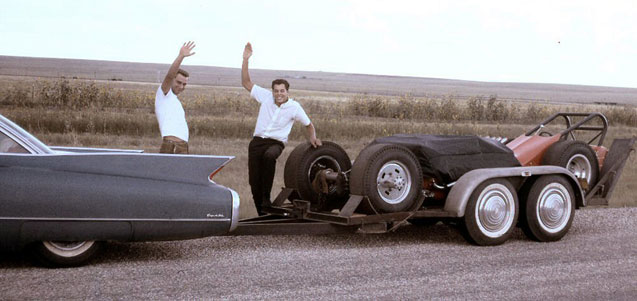 |
"This is the trailer for the four-engine car. Unfortunately, just as I got the car done, I started acting in a television series called Margie, and the studio put the kibosh on me driving. So my pal Prudhomme did the driving, and we built another lollypop trailer for it. It’s colored light rust in this picture because it hadn’t been painted yet --- but it had Caddy hubcaps on it to match the Caddy tow car, so we were stylin' again! Only this time, we had steel drop-down loading ramps, and, of course, the trailer had to be a lot sturdier to haul the titanic around on it. That's Prudhomme and our old pal Tom McCourry smiling and waving at me taking the picture."
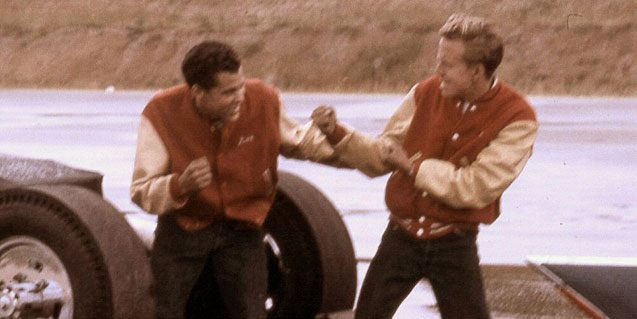 |
"Things weren’t as rosy as they looked as in the last photo. I always seemed to rub Prudhomme the wrong way, and he got all pissy with me, like when I replaced his shampoo with 10-weight oil in the motel at night or when I asked him to hold onto the wires of the magneto while I was getting ready to put it in the engine and then give it a spin. I only electrocuted him once that way, though, and then he knew better than to fall for it again!"
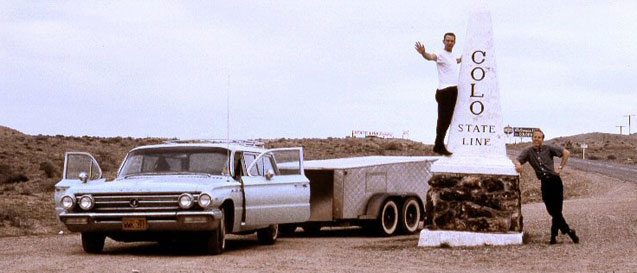 |
"In the last two photos, you can see the big custom bag that Tony Nancy made to put over the engine when it rained --- and that was a very expensive bag. We made the first major update to my trailers by enclosing it. In this shot, we were on our way to run Continental Divide Raceway for the weekend. Prudhomme had picture-taking duty on this one."
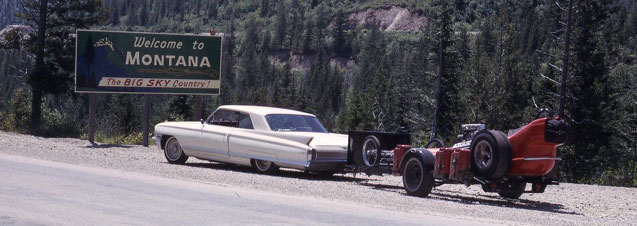 |
"This is from my second tour (after the TV show was canceled) with the Barnstormer (my first fuel car). The trailer was much the same construction, but a little heavier than the twin-engine lollypop trailer but no enclosure. The fuel car needed more spare parts, so we put a big steel box on the front of the tongue with a spare motor and many small parts in it. It was a real tail dragger for the push car, even with an Eze-Lift hitch on it. I put small locks and chains on the Jeep cans that had the nitro in them, not so much to keep them safe, but more to know if Garlits or Prudhomme or anyone else had messed with my fuel and put water or something else in it --- like I'd do to them if I was given half a chance! Keep in mind we were on a full season-long tour across the country with this minimal rig and didn’t return home till the fall. "
 |
"For the second year with the Barnstormer, we got sophisticated and built an enclosed trailer that even had a sleeping compartment over the front of the race car for those times when you couldn’t find a vacant motel during the tourist season. It was so low you had to walk around on your knees. It wasn’t exactly what you’d call a motorhome!"
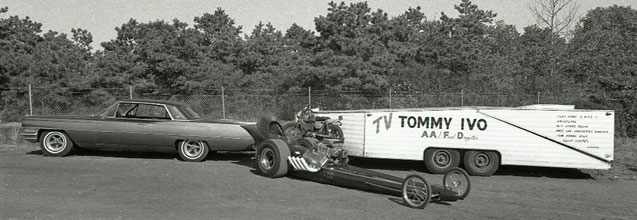 |
"This was my second try at an enclosed trailer, and it had a black cloud hanging over it. Right off the bat, we took it up to San Francisco for its maiden voyage, and we had a flat. You couldn’t really feel it with a twin-axle trailer like that, so you kept you eye on the rearview mirrors for smoke coming from the tire wells when it had enough of running flat and started looking like it was doing a burnout. We just got it changed, and bingo, the lights went out again!
"I saw smoke drifting off the back of the trailer again -- damn, another flat -- and we only had one spare. But upon examining the tires after we stopped, they were all good. Then I noticed some smoke leaking out of the crack where the hatch lifted up. So I opened up the lid and -- poof! -- I had no eyelashes or hair on the front of my head when the fire inside that came roaring out. The first tire must have been smoldering when we put it in there, and the inside of the trailer caught on fire. No one ever accused me of being the sharpest knife in the drawer. Good thing we hadn’t painted the dragster yet.
"Ah, but we weren’t done yet. You can just see over the car in the foreground one of two dirt bikes I’d mounted on each side of the front of the box that year. 'Total Performance' (as I nicknamed my tire wiper that year, with good reason) drove through the toll booth on the way up there and didn’t give it enough clearance to get the bike past the booth, and off came the toll-booth door as the bike ricocheted between the trailer and the toll booth. He messed up one more time (but that’s another story), and he was 'down the road!' "
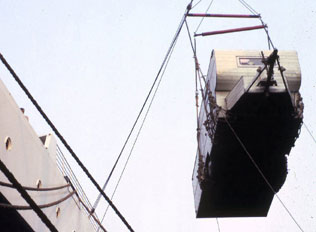 |
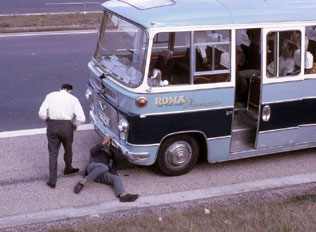 |
"My heart was in my throat when I went overseas to attack England in 1964 with the 'Swamp Rat' (Garlits). When they grabbed it around the side braces and slung it 15 stories into the air to put it aboard ship, I was surprised not to see the cover come loose and the bottom fall out of it, raining parts down like a broken piñata.
"While we were in England racing in 1964, they hauled us around from track to track in these little buses with these tall glass windows that ran from your armrest up to the roof.
"Now this isn’t so special now days, but keep in mind that at that time, the Greyhounds in this country just had these little portholes for windows. We used to wear the hinges off the doors on the trailer opening and closing them when the people saw my name on the side of trailer and wanted to see the car.
"Shazam! The light bulb went off over my head! I’d just make a trailer with glass sides on it, and they could look all they wanted. Besides, we wouldn’t have to unload it every time we displayed it and could leave it overnight in front of Buick agencies.
"That’s Garlits lying on the ground, fixing a funny noise that was coming from the engine compartment. He fixed it all right -- it wouldn’t start after he got done, and we ended up on the hook. That’s K.S. Pittman asleep inside, next to the window on the far right."
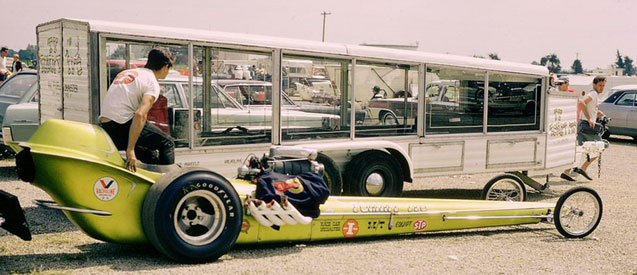 |
"My first glass trailer was born. It sported black outdoor carpeting on the floor and a passenger-car-type, perforated, white, custom-installed Tony Nancy headliner. The windows were just plain storefront glass (note the alarm-system tape). Plexiglas would scratch too easily when you washed it to get all the road-barnacle dirt off. We left town on the first tour, and 20 miles down the road, some gawker drove right into the side of me and tore the left fender off. Ye gods … how do you run into the side of what you’re looking at? Sigh!
"We went back home and fixed it and got on the way again later that night and got 45 miles, this time to Ontario, when some other birdbrain fell asleep at the wheel and steamed full-tilt boogie into the back of us. Why do catastrophes with trailers come in pairs? Double sigh!"
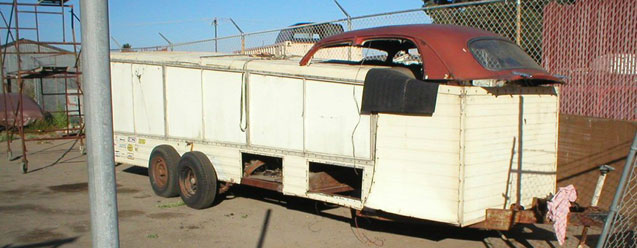 |
"RIP, my poor, poor first glass trailer. Some guy in Pismo Beach, Calif., told me he had it, so I drove up to see it. It had been sitting for more than 40 years but was so rotted out it wasn’t worth having. The windows were in perfect shape, though, and covered with white sticky paper. We only broke one window all the time I used glass trailers, and that was because I was being lazy and just threw a third member in with the car, and it rolled over and broke the glass when we went around a corner. At times, I’m afraid I was a few bricks shy of a load when it came to thinking things through."
 |
"Cars got longer, and so did the second-generation trailers. The cars also needed more parts and collateral material to run them, so it also needed far more storage. By this time, we had a generator onboard for working on the car in the pits, so I’d fire it up at night when we were driving down the Pennsylvania Turnpike, and it looked like a jewel showcase going down the road. The CBs were abuzz with the truckers talking about, 'Did you see that Tommy Eye-vo car going west?' The tongues of those poor, poor Cadillacs were hanging out by the time we got home each year. It was like pulling the weight of four more Cadillacs around behind them for close to 100,000 miles each year. They did it without missing a heartbeat (for the most part, anyway). Those Caddys made good tow trucks!"
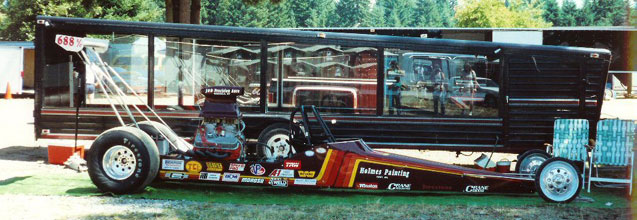 |
"This trailer ended up in Seattle. You can see another reason why I didn’t use Plexiglas, like this guy replaced the glass with. Without the super-flat surface of the window glass, the reflections were all wavy and goofy, which distorted the view of the car."
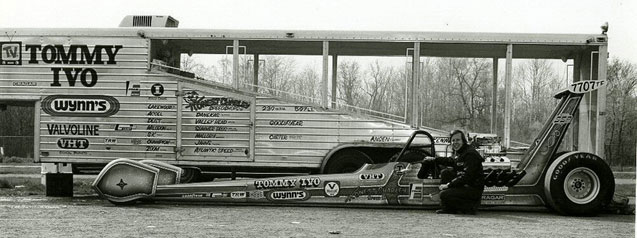 |
"I finally had to capitulate and go to a fifth-wheel trailer. The weight of the trailers had finally gotten completely out of control for a poor, poor Cadillac to be pulling them around with a tongue trailer anymore. If the trailer had a bad problem, it would shake the tow car around as bad as Prudhomme used to shake me around when he got mad at me and grabbed me by the scruff of the neck of my firesuit and swung me around in the air at the end of the track (until 'Tarzan' [John Austin] got down there with the push car and told him, 'OK Prudhomme, put him down' -- he was afraid of 'Tarzan'!).
"My butt was dragging by the end of the winter building season that year. I built both a new glass trailer and made a major change in my dragster as well, going from a front- to a rear-engine dragster, with the heavy-duty learning curve that it brought along with it. The added height of the wing dictated a new shape for the car compartment, but it also gave us enough height to build a reasonable-sized sleeping compartment in the front. It had a shower, VCR, TV, refrigerator, and microwave. It also sported a comfortable-sized bed and was air-conditioned (see the compressor on the roof). Man, was that better than the back seat of the car or the sleeper box we used to all put on the pickup trucks … I was in doggie heaven!
"The hair-raising thing about it, though, was that there were no windows in it. When you were going down the always-bumpy roads and drove onto a newly paved portion of the highway, you would wake up from a dead sleep and think it was so smooth that maybe we were flying through that air because they had driven off a cliff with the tow truck and would just be panicked, waiting to hit the bottom of the canyon. You see that wouldn’t be a good thing, with the dragster and all the spare parts, nitro, engines, tires, and on and on in the rear of the trailer. When you hit the ground (or even something solid like a head-on with an 18-wheeler), all the weight would shift from the back of the trailer through the flimsy room-divider wall and stack up in the front of the trailer --- where you were!
"One other little sidebar: See that airplane-landing spotlight aimed toward the back, on the very top of the rear-left side of the back edge of the roof? I had it hooked up to a toggle switch under the dash, and when some bozo would drive up behind me with his bright lights on, I’d give him a little taste of the light, and if he didn’t dim his brights, I’d turn it on and leave it on till he did.
"It worked until one night on the Jersey pike. I bleeped the light once with no success at some nitwit behind me with his bright lights on, and then turned it on and kept it on when he didn’t dim down. I was looking out the rearview mirror at the two headlights to see when he would catch on and dim them, but instead of that, two more little red lights came on about roof height on the car! Jiggers, it was the cops --- that was the last time I did that!
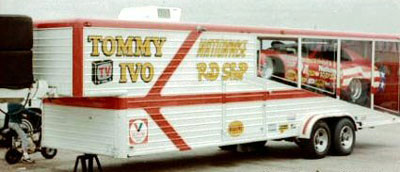 |
"When we changed to the Funny Car, I used the same trailer and shortened the car compartment to fit the shorter Funny Car, and this gave us more room to make a sleeping/shop compartment in the front.
"We needed a shop with a workbench in it to keep up with the ever-expanding workload that those damn Funny Cars brought along with them. Up to that point, we could get away with just using the tailgate of the truck as a workbench between rounds."
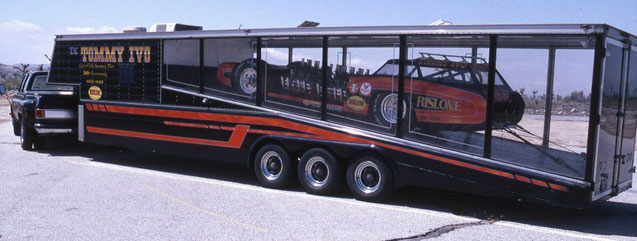 |
"I built my last glass-sided trailer to use with my jet dragster, and then used it again for my Last North American Tour. (I was going to give up the match race circuit and go national event racing, where the money had gone, but little did I know I was going to be giving up racing altogether after I crushed three vertebrae in my back in a crash on that tour.) It housed my four-engine car, which had since been modified from the Showboat dragster version after I sold it to the Wagon Master Funny Car version. Being the latest one in the evolution of my glass trailers, it was a triple-axle, swoopiest one of the bunch."
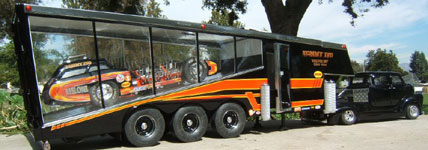 |
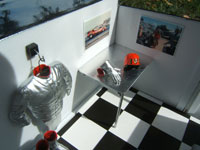 |
"Is it real or is it Memorex? John Teresi built a 1/24th-scale model of the Wagon Master in the glass trailer. He has a nifty way of shooting a picture of it on the edge of a tabletop that makes it look like it’s full size.
"John also made the roof of the model glass trailer removable, so you could look into the front sleeping compartment. Of course, this is his version of what was inside. But I thought it was neat enough to show you a picture of, with the firesuit, helmet, and all."
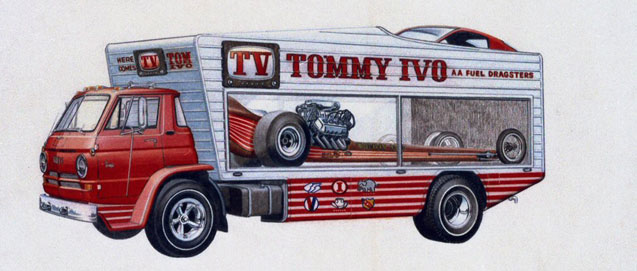 |
"The crème de la crème of my glass haulers was my glass-sided truck. Here’s a picture of the rendering of it by Steve Swaja that I sent to the track owners on my Christmas cards back in 1970 when I built it."
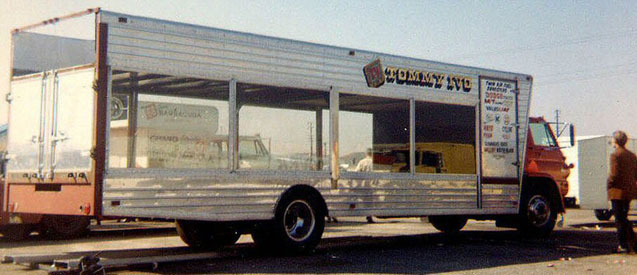 |
"I was licking my chops, I was so anxious to get started on this project. Here’s a work-in-progress picture of it. It was the perfect hauling vehicle. It was just a 'big car,' but -- and here comes the 'but' again -- the dimwit who sold me the truck was one of those know-it-alls and convinced me not to put power steering in it because he said it would wander on the highway -- NOT! You had to stand on first one corner of the dash and then the other in order to turn the steering wheel. It was so impossibly stiff, it took six men and a small boy to turn it from lock to lock. As many times as you had to turn it to get around the tight-quartered pits, it was a soup sandwich!!!
"You can also see it has one axle here. When we first left on tour, we made it all the way to Louisiana, where we ran across the scales, and they told us we were overloaded on the single rear axle. Fortunately, we unloaded the Corvette and could press on to the race in New Orleans and then put another axle under it. It was sashaying so hard going down the road before that, I’m surprised both 'Tarzan' and me didn’t end up in body bags!"
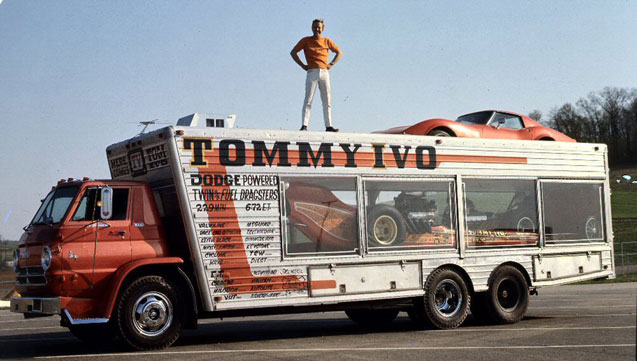 |
"Ta-da! This was 'TV Tommy' Ivo -- Master Showman at my best. By the way, that’s the name of my autobiography book. It will be coming out next spring from Motor Books with all my adventures from the movies to racing. The book’s author is the talented and clever Tom Cotter, and it’s not my humble writing, like this story.
"This was really the first big rig. At that point, no one had come up with the18-wheelers yet. When we had it in the pits at Indy that year, it stuck out over the pits like a monolith, towering over the other normal-height trailers, and you could see the 'Tommy Ivo' on it from one side of the pits to the other.
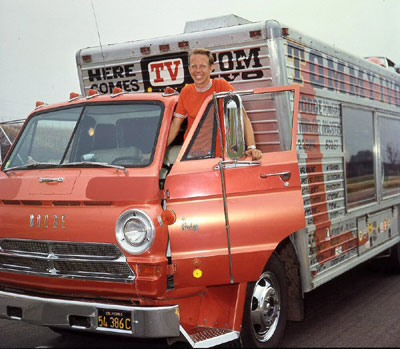 |
"I was a kid with a new toy! I did my best to make it into a Cadillac, though. It had a Coupe de Ville seat in it, with all the Caddy accessories like cruise controls, light dimmers, and a ground-pounding stereo that was state of the art. The living quarters in the truck body were accessible via a leather tunnel sleeve that snapped out when we had to tilt the cab forward to get to the engine. It went where the back cab window use to be. But 'Tarzan' would bitch at me constantly, when I was back there watching TV in bed and eating the popcorn that I’d just freshly popped up (I was a popcorn-oholic). Hey, what can I say? We left in March every year and never saw home again till November!!! You had to have your creature comforts along with you.
"As you can see from the TV antenna and air compressor on the roof, the people compartment was state of the art. One time, we were going down the Pennsylvania pike, and I was asleep in the people compartment, and 'Tarzan' was racing Kalittas' guys with their truck and trailer. When the cops pulled us over, he said he had never seen anything that big going that fast before. I heard 'Tarzan' ask him, 'Are you going to give me a ticket?' The officer replied, 'Yes,' and then 'Tarzan' (in his own unique way of being the one and only 'Tarzan') told him something very unpleasant about his mother. I heard the handcuffs click, and it was “Hi-ho, hi-ho, it’s off to jail I go,' and he was gone (no, he didn’t pass GO either). The fuzz had no idea I was in the sleeper, or I’d have probably ended up in the slammer, too!
"When I got home, they wrote me a letter from the Pennsylvania Highway Department that my driver had lost his license to drive in Pennsylvania for six months. I was Tommy Ivo Inc., so they thought they were sending it to a corporation. I wrote them back and thanked them for the information and told them I had fired Mr. Austin because of this, and he was so depressed that he shot himself, his wife, and four kids!!! I never heard back from them!"
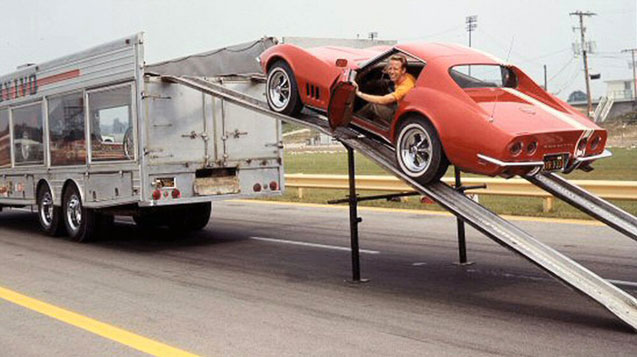 |
"The loading and unloading process each time was like working in a circus putting up the tent. In fact, the other racers asked me when I was going to put the calliopes on it. The ramps came out of the slot to their compartment where they lived (you can see the opening just above the bumper), and we erected them by hand. Then we dropped the front of them down from where they hooked onto the top of the truck to the level at the bottom of the doors, and the dragsters came out on the same ramps. The fly in the ointment was that we didn’t have a winch. You just didn’t go down to the store and buy one in those days, and 'Tarzan' said we didn’t need one. WRONG! At the races, it was OK with all the help we could get in the pits, but when it was just me and him trying to do it, two guys were doing what it really took four to do.
"We carried two cars, the primary car and a backup. After a while, the primary car wouldn’t handle -- it really needed to be fronthalved; something was seriously wrong -- so until we got a replacement with a new car from Don Long, we ran the backup car for three months. That meant we had to unload the entire rig every time we ran the car because they would only fit in the truck one way, with the body on one car and not the other. The second and fourth window on the side swung open and would let the backwards 'backup' dragster slide out through the windows far enough on the tracks it sat on to let the wheels of the two dragsters pass each other when we took the primary dragster out of the ramps. It was oversize width; we had made the car compartment wide enough to just roll cars past each other.
"We ran eight times in one week that year – a personal best! We ran Atco, N.J., on Sunday afternoon and Englishtown on Sunday night. By the time that Monday came around, neither 'Tarzan' nor me knew if we were afoot or on horseback!!!"
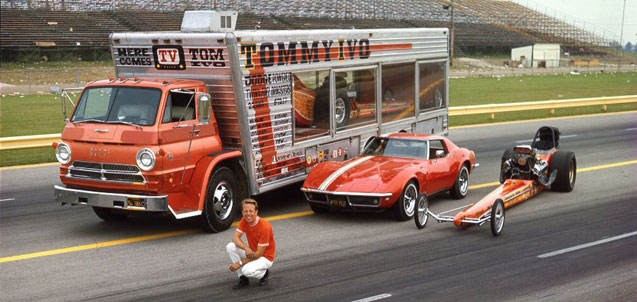 |
"Oddly enough, I had indeed fallen on the perfect towing operation. See any big rigs in the pits now days? If it hadn’t been that it is such a nightmare with the steering and no winch for loading the dragsters, I would have most likely kept building trucks from that point on.
"To sum it all up, I rented it to a show promoter for the winter, and at the end of the season, we parked it at his shop in Detroit. We started to drive off, and 'Tarzan' said, 'Wait a minute; back up.' I thought he had forgotten something he left behind. When we backed up even with the truck, he rolled down his window and spit on it -- he hated that truck!"
So there you have it race fans, a look at the evolution of race car hauling up until just about the time of the 18-wheelers (of course, John Bandimere Sr. had an 18-wheeler hauler at the first Nationals in 1955, but that's another story). Thanks so much to Ivo; in my book, he truly is, as he likes to call himself, "Your hero and mine."



















































